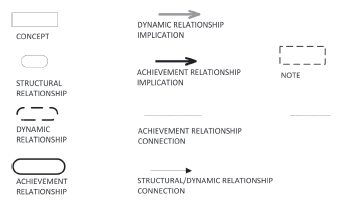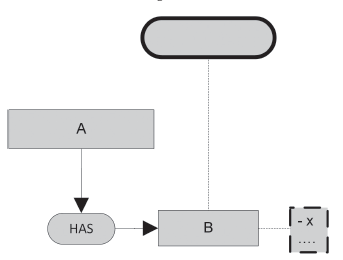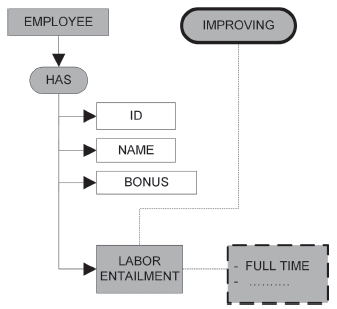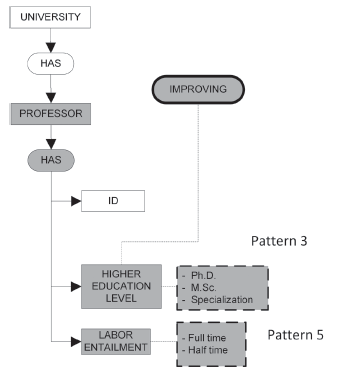Introduction
Performance measurement is crucial for achieving business success. According to Cosenz (2013), "what cannot be measured cannot be controlled." Therefore, strategies and assessment practices focused on performance measurements need to be implemented. Besides, the determination and analysis of such measurements in terms of key performance indicators facilitate the holistic management of an organization (Kronz, 2006). Business success also relies on the fulfillment of the organizational strategic objectives, and they are essential for leading an integrated management (Basili et al., 2010; Basili, Lampasona, & Ocampo, 2013).
Verifying the achievement of the organizational strategic objectives is a difficult task (Basili et al., 2010). Hence, performance measurement has been considered as a main factor for verifying such an achievement (Basili et al., 2010; Trendowicz, Heidrich, & Shintani, 2011). According to Basili et al. (2013), an integrated vision of the organization can be obtained by adequately determining performance indicators and their relationships with the organizational strategic objectives (Basili et al. , 2013). In some companies, performance measurement indicators have been determined; however, little effort to adequately treat relationships between objectives and performance indicators, has been devoted (Wu, 2012).
Relationships among organizational strategic objectives and key performance indicators have been studied in a variety of contexts. Accordingly, some proposals aimed at addressing organizational objectives, KPIs, and objective-KPI relationships have been suggested. More detailed information of this proposals and a comparison of them are presented by Zapata and Castro (2016). The analyzed proposals exhibit some drawbacks associated with the lack of reusability and traceability. For example, some proposals are essentially theoretical, and specifications for guiding any computational tractability are neglected. Other proposals are subjectively used to determine the KPIs and the objective-KPI relationships by only using personal criteria.
In this paper we propose a set of patterns based on pre-conceptual schemas (Castro & Zapata, 2013; Zapata, Giraldo, & Londoño, 2011) for supporting the assessment of KPIs and the KPI-objective relationships. This proposal is aimed at overcoming the aforementioned disadvantages. First, we use pre-conceptual schemas for representing organizational objectives, key performance indicators, objective-KPI relationships, and the involved domain elements. Then, we define a set of patterns in order to assist the derivation process of candidate KPIs from organizational strategic objectives.
Even though patterns have been usually applied to areas related to software programming, software and system design, data modeling, and system analysis, they have been also studied from an organizational perspective (Behnam et al, 2012; Niwe & Stirna, 2009). Patterns in the enterprise environment are proven being useful for providing reusable solutions to specific, important, and recurring problems; besides, they assist descriptions by using repeatable features(Niwe & Stirna, 2009). Thus, the patterns identified in this proposal are focused on promoting a reusable and traceable derivation process, which is carried out in a systematic way. Finally, we present a lab study for representing objectives, KPIs, objective-KPI relationships and relevant domain elements. Also, the process for deriving a set of candidate KPIs from a given strategic objective is illustrated by identifying and applying certain patterns.
This paper is organized as follows: in Section II, we relate some approaches for addressing objectives, indicators, and their relationships. Besides, we describe some work for applying the concept of pattern to the organizational level. In Section III, we describe the proposal based on patterns for deriving key performance indicators from strategic objectives. In Section IV, we provide a lab study in order to illustrate the main aspects of the proposal. Finally, in Section V, we present some conclusions and future work.
Background
Objective-KPI relationships
Several proposals aimed at determining indicators and the relationships among objectives and indicators have been developed. A more detailed review of such proposals is presented by Zapata and Castro (2016). Some proposals are essentially theoretical, and specifications for guiding any computational tractability are neglected. In other proposals, KPIs are subjectively related to objectives and KPIs are determined by using natural language. Finally, none of such proposals provides a systematic approach for deriving indicators from a specific organizational strategic objective. In conclusion, the implementation of reusable and traceable solutions based on KPI has several drawbacks.
Organizational patterns
Several definitions have been established for describing the concept of pattern in the organizational domain. Our conception of pattern is based on the following definitions:
Prekas et al. (1999) define patterns as "generic and abstract design proposals, solutions to recurring problems within the sector of interest that can be easily adapted and reused."
Stirna, Persson and Aggestam (2006) define organizational patterns as "generic and abstract organizational design proposals, which can be easily adapted and reused and that represent solutions to specific problems within an organization."
Sandkuhl (2012) defines organizational knowledge pattern as "a formalization of knowledge for a recurring organizational task abstracting from organization-specific aspects, which is of value for an organizational actor and an asset for an organization."
Behnam and Amyot (2013) define the concept of pattern families as "collections of related patterns used for capturing and reusing domain knowledge." Additionally, the authors state "a pattern can be thought of as a reusable model that describes a need and solves a problem, which may occur at different levels of abstraction."
Usually, patterns have been focused on areas related to software programming, software and system design, data modeling, and system analysis. However, patterns in the enterprise environment have been used for describing concepts by using regular and repeatable features (Prekas et al., 1999).
Prekas et al. (1999) use patterns as means for assisting the management of knowledge in situations of change, and the dissemination of gained experience from similar situations. The approach is illustrated with examples from a study of change management in the electric sector.
Also, patterns have been introduced in organizational design, where work product designs represent solutions to specific, important, and recurring problems within organizations. An interesting proposal (Rolland, Grosz, Loucopoulos, & Nurcan, 1998; Rolland, Loucopoulos, Grosz, & Nurcan, 1998; Rolland, Nurcan, & Grosz, 2000) comprise: (i) a framework for discovering generalized patterns of change management in order to reuse them in similar situations within electric companies; (ii) the structure of a knowledge repository of good business practices for managing change in organizations; (iii) a web based tool aimed at retrieving and accessing this knowledge; and (iv) a decision-making pattern based on the EKD (Enterprise Knowledge Development) method. This pattern is used to offer a domain-specific guidance by using a library of domain-specific knowledge. Next, such a library is used for matching the current context of work-represented as EKD process. After that, EKP (Enterprise Knowledge Patterns) approach was proposed. This approach is aimed to support activities related to knowledge management in an organization (Bubenko, Persson, & Stirna, 2001). These patterns are focused on gathering, maintaining, and sharing best business practices for creating the organizational memory. EKP approach was applied in a consultancy firm in order to improve the exploitation and exchange of organizational knowledge (Persson, Stirna, Gernot, & Günter, 2003). Also, EKP has been proposed for reviewing a set of problems involved in B2B transactions and presenting generic and reusable solutions-patterns-to them (Niwe & Stirna, 2009).
Sandkuhl (2012) present the concept of OKP (Organizational Knowledge Patterns), which is focused on reusing organizational knowledge. Sandkuhl (2011) proposes OKP for capturing knowledge about proven solutions and facilitating reuse of knowledge related to information demand.
GoPF (Goal-driven Pattern Family) is an additional framework comprising collections of related patterns, which are useful for capturing and reusing domain knowledge (Behnam, 2012; Behnam & Amyot, 2013). This framework aims at capturing business goals, business processes, and linkages for defining relationships among them. GoPF has been used for capturing the screening intentions, expected outcomes, and processes related to the aviation security domain (Behnam et al., 2012).
The aforementioned approaches demonstrate the advantages of using patterns, particularly in the organizational context. Thus, we consider the patterns as adequate tools for assisting our derivation process of candidate KPIs from organizational strategic objectives. A similar use of patterns is presented by Martínez (2008), and Martínez, Pastor, Mylopoulos, and Giorgini (2008). The authors propose a catalog of patterns for reducing the abstraction level between early requirements and late requirements. Such patterns allow for analyzing elements of an organizational model, such as tasks, resources and goals. Then, a new organizational actor is inserted in order to represent the software system to be developed. As a result, a new intermediate model containing relevant information to be automated is derived from an initial organizational model.
Unlike the work presented by Martínez (2008) and Martínez et al. (2008), in our proposal: (i) we use pre-conceptual schemas modeling the organizational domain; and, (ii) we obtain a set of candidate KPIs related to a given strategic objective.
Our proposal
In this paper, we propose a set of patterns based on pre-conceptual schemas for supporting the identification of KPIs and their relationships with organizational strategic objectives. These indicators are useful for assessing the accomplishment of such objectives. The method for applying the proposed patterns is defined in a previous work presented by Zapata and Castro (2016). Such a method includes the modeling of a particular domain related to an organizational strategic objective, the application of a set of patterns, and the derivation of a candidate set of KPIs. As a result, reusable and traceable solutions can be provided. The reusability is ensured by identifying a set of patterns within the modeled domain and applying a systematic method for deriving KPIs. Once patterns have been identified, the traceability is ensured by mapping elements from the objective domain to elements of the KPI domain.
The KPIs derivation process is carried out in a systematic way by identifying those relevant elements into the model suggested by the stakeholder and by analyzing such elements. In order to complete such a task, we provide a set of patterns based on pre-conceptual schemas and a solution for systematically guiding the derivation process.
Description of the pattern
The basic elements for describing the proposed patterns are based on the template developed by Martínez (2008). Such elements are:
Name: A sentence summarizing the pattern.
Context: A situation characterizing a problem. It describes situations in which the problem occurs.
Problem: The recurrent problem arising from the context.
Structure: A detailed specification of the structural aspects of the pattern.
Solution: The strategy for solving the recurrent problem. Examples: A model intended to illustrate the pattern.
Proposed patterns
The patterns proposed in this paper are intended to be used according to the type of elements and relationships identified within an organizational objective model. Each of the modeled elements should be analyzed in order to determine if such an element can be considered as a candidate element -a candidate element should match the structure described in any of the proposed patterns. Once a candidate element and its linkages have been analyzed, a suitable pattern can be identified. Lastly, the procedure described in the solution of the identified pattern should be followed up in order to carry out the derivation of KPIs from the modeled organizational objective.
The patterns are structured by a set of elements based on pre-conceptual schemas, which include five kinds of nodes connected to two kinds of arcs for graphically illustrating a model (Castro & Zapata, 2013; Zapata et al., 2011). A concept node has a connection-type arc either starting or ending in a relationship node. Such elements are the following:
Class-Concept is a concept which contains attributes and can be instantiable.
Attribute-Concept is a leaf concept within a pre-conceptual schema, i.e., an attribute of a Class-Concept.
A dynamic relationship represents actions and has exactly one incoming and one outgoing connection arcs. Such a relationship can be connected to concepts by using connections arcs. Also, it can be connected to other dynamic relationships by using implication arcs.
An Instance represents a set of values which may be taken by a concept. An instance is denoted by a dashed rectangle. A set of instances is linked to a concept by using a dashed line.
A structural relationship can be either is-a or part/ whole type. It is incident to concepts and it has exactly one incoming and one or more outgoing arcs of connection type.
An achievement relationship can be connected to structural and dynamic relationships and concepts (Lezcano, 2007). Also, achievement relationships can be connected among each other by using implication arcs. The achievement relationships considered in this paper are treated as improvement-type.
A connection arc connects a concept to a relationship and vice versa.
An implication arc connects a dynamic relationship to a dynamic relationship. Implication arc can be also used for connecting achievement relationships among each other.
The basic notation of the pre-conceptual schemas is illustrated in Figure 1.
In this Section, the patterns 3-5 are explained in detail by using the structure defined by Martínez (2008). The patterns 1 and 2 can be consulted in our previous work (Zapata & Castro, 2016).
Pattern 3
Name. The instantiated attribute-concept pattern.
Context. This pattern is applied when an attribute-concept -which is related to an achievement relationship- can be used for generating a set of candidate KPIs. Besides, the attribute-concept is related to an instance. An example of this structure is shown in Figure 2.
Problem. The problem relies on generating a set of KPIs from a candidate instantiated attribute-concept.
Structure. The elements involved in this pattern are the following:
Candidate attribute-concept.
Achievement relationship linked to the candidate concept.
Structural relationship linked to the candidate concept, which is part/whole type.
Instance linked to the candidate concept.
Solution. We apply this pattern as follows:
A KPI is derived by writing the number of function followed by the label of the source concept in the structural relationship in plural form.
A KPI is derived by writing the number of function, the label of the source concept in the structural relationship in plural form, the word with, and the label of the candidate concept followed by the value of each instance between « ». ».
number of A (plural)
number of A (plural) with B « x »
percentage of A (plural) with B « x »
Example. The application of the instantiated leaf-attribute pattern is illustrated in Figure 3.
Figure 3 illustrates the occurrence of pattern 3, so a set of candidate KPIs is derived by following the process described in the solution section corresponding to pattern 3. As a result, the candidate KPIs are:
number of EMPLOYEES
number of EMPLOYEES with LABOR ENTAILMENT « FULL TIME »
percentage of EMPLOYEES with LABOR ENTAILMENT « FULL TIME»
Pattern 4
Name. Composition of attribute-concept and instantiated attribute-concept pattern.
Context. This pattern is applied when an attribute concept -which is related to an achievement relationship- can be used for generating a set of candidate KPIs. Besides, such an attribute-concept has a sibling node of instantiated attribute-concept type. An example of this structure is shown in Figure 4.
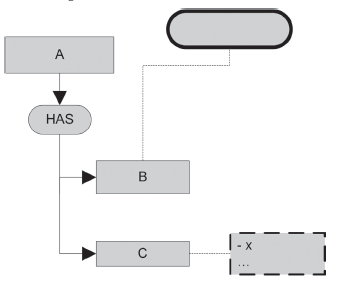
Source: Authors
Figure 4 Composition of attribute-concept and instantiated attribute-concept pattern.
Problem. The problem relies on generating a set of KPIs from a candidate attribute-concept, which has a sibling node of instantiated attribute-concept type.
Structure. The elements involved in this pattern are the following:
Candidate attribute-concept.
Achievement relationship linked to the candidate concept.
Structural relationship linked to the candidate concept, which is part/whole type.
Sibling attribute-concept.
Instance linked to the attribute-concept.
Solution. We apply this pattern as follows:
A KPI is derived by writing the sum of function, the label of the candidate attribute-concept in plural form, the word of, the label of the source concept in the structural relationship in plural form, the word with, and the label of the instantiated concept followed by the value of each instance -between « ».
A KPI is derived by writing the maximum function, the label of the candidate attribute-concept, the word of, the label of the source concept in the structural relationship, the word with, and the label of the instantiated concept followed by the value of each instance -between « ».
A KPI is derived by writing the minimum function, the label of the candidate attribute-concept, the word of, the label of the source concept in the structural relationship, the word with, and the label of the instantiated concept followed by the value of each instance -between « ».
A KPI is derived by writing the average function, the label of the candidate attribute-concept, the word per, the label of the source concept in the structural relationship, the word with, and the label of the instantiated concept followed by the value of each instance-between « ».
sum of B (plural) of A (plural) with C « x »
maximum B of A with C « x »
minimum B of A with C « x »
average B per A with C « x »
Example. The application of the instantiated leaf-attribute pattern is illustrated in Figure 5.
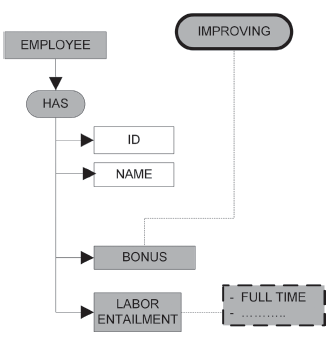
Source: Authors
Figure 5 Application of the composition of attribute-concept and instantiated attribute-concept pattern.
Figure 5 illustrates the occurrence of pattern 4, so a set of candidate KPIs is derived by following the process described in the solution section corresponding to pattern 4. As a result, the candidate KPIs are:
sum of BONUSES of EMPLOYEES with LABOR ENTAILMENT « FULL TIME »
maximum BONUS of EMPLOYEE with LABOR ENTAILMENT « FULL TIME »
minimum BONUS of EMPLOYEE with LABOR ENTAILMENT « FULL TIME »
average BONUS per EMPLOYEE with LABOR ENTAILMENT « FULL TIME »
Pattern 5
Name. Composition of instantiated attribute-concept and instantiated attribute-concept pattern.
Context. This pattern is applied when an instantiated attribute-concept -which is related to an achievement relationship- can be used for generating a set of candidate KPIs. Besides, such an attribute-concept has a sibling node of instantiated attribute-concept type. An example of this structure is shown in Figure 6.
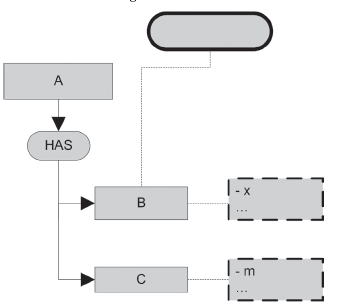
Source: Authors
Figure 6 Composition of instantiated attribute-concept and instantiated attribute-concept pattern.
Problem. The problem relies on generating a set of KPIs from a candidate instantiated attribute-concept, which has a sibling node of instantiated attribute-concept type.
Structure. The elements involved in this pattern are the following:
Candidate instantiated attribute-concept.
Achievement relationship linked to the candidate concept.
Structural relationship linked to the candidate concept, which is part/whole type.
Sibling instantiated attribute-concept.
Instance linked to the candidate attribute-concept.
Instance linked to the attribute-concept.
Solution. We apply this pattern as follows:
A KPI is derived by writing the number of function, the label of the source concept in the structural relationship in plural form, the word with, the label of the candidate attribute-concept, the value of each instance associated with the candidate attribute-concept -between « », the words: which have, the label of the instantiated attribute-concept, and the value of each instance associated with the instantiated attribute-concept -between « »
number of A with B «x» which are with C «m»
Example. The application of the composition of instantiated attribute-concept and instantiated attribute-concept pattern is illustrated in Figure 7.
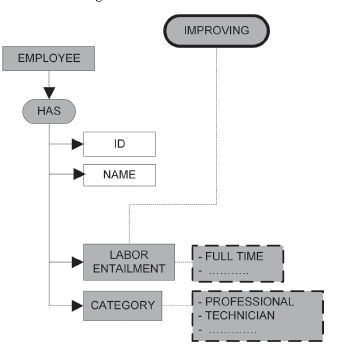
Source: Authors
Figure 7 Composition of instantiated attribute-concept and instantiated attribute-concept pattern.
Figure 7 illustrates the occurrence of pattern 5, so a set of candidate KPIs is derived by following the process described in the solution section corresponding to pattern 5. As a result, the candidate KPIs are:
number of EMPLOYEES with LABOR ENTAILMENT «FULL TIME» which have CATEGORY « PROFESSIONAL»
number of EMPLOYEES with LABOR ENTAILMENT «FULL TIME» which have CATEGORY « TECHNICIAN»
Lab Study
In this Section, we present a lab study related to the organizational objective "IMPROVING HIGHER EDUCATION LEVEL OF THE PROFESSORS." In this example, the domain related to such objective is modeled. So, "IMPROVING HIGHER EDUCATION LEVEL OF THE PROFESSORS" is represented by the achievement relationship IMPROVING and the concepts: UNIVERSITY, PROFESSOR, ID, HIGHER EDUCATION LEVEL, and LABOR ENTAILMENT. Besides, some instances are related to the concepts HIGHER EDUCATION LEVEL and LABOR ENTAILMENT.
After the relevant concepts and their relationships have been modeled, we can analyze the application of the proposed patterns. As a result, pattern 3 and pattern 5 are identified and a set of candidate KPIs are derived. This example is illustrated in Figure 8.
As a result, the set of candidate KPIs related to the organizational objective "IMPROVING HIGHER EDUCATION LEVEL OF THE PROFESSORS" are summarized in Table 1, including the pattern applied for selecting the candidate KPI.
Conclusions and future work
The accomplishment of the strategic objectives is crucial for attaining organizational success. Therefore, control actions aimed at ensuring such accomplishment are required. Such actions should be assisted by adequate methods, which allow us to reason about the fulfillment of the strategic objectives. KPIs are proven, effective resources for assessing such fulfillment. We analyze several proposals aimed at treating objectives, indicators, and their relationships and we discover some drawbacks associated with the lack of reusability and traceability. Accordingly, we proposed a set of patterns based on pre-conceptual schemas for deriving KPIs from strategic objectives as a way to address the identified drawbacks. Then, we demonstrated the application of the proposal by using a lab study.
As a result, we experienced the advantages of using the pre-conceptual schemas as a tool for representing some domain. Such advantages rely on the proximity to the stakeholder language and the capacity for overcoming ambiguity problems. Moreover, the systematic application of the proposed patterns overcame the discovered drawbacks, and demonstrated relevant advantages concerning the reuse and the traceability of solutions to recurrent problems.
Lastly, by applying the proposed patterns in this paper, the stakeholder is provided with a set of candidate KPIs intended to assess the fulfillment of the organizational objectives. Such KPIs are systematically obtained from a particular domain modeling, and they match the own and specific needs of an organization.
As future work, we intend to apply the proposed patterns by using other different domains and by comparing the results with the established indicators by specific frameworks. We will further automate the derivation process of KPIs.













